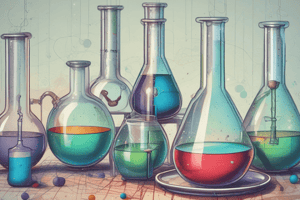Podcast
Questions and Answers
What is the purpose of mass % in solution calculations?
What is the purpose of mass % in solution calculations?
- To calculate the number of moles of solute per liter of solution
- To measure the freezing point depression of the solution
- To find the gram equivalents of solute per liter of solution
- To determine the amount of solute in grams present in 100 grams of solution (correct)
Define Molarity in chemical methods of solution calculation.
Define Molarity in chemical methods of solution calculation.
Molarity is the number of moles of solute dissolved per liter of solution.
Parts per million (ppm) is the amount of solute in milligrams present in one million milligrams of the ___.
Parts per million (ppm) is the amount of solute in milligrams present in one million milligrams of the ___.
solution
What type of isomers have the same molecular formula but different bonding arrangements?
What type of isomers have the same molecular formula but different bonding arrangements?
Which functional group is represented by -OH?
Which functional group is represented by -OH?
Temperature does not affect reaction rate.
Temperature does not affect reaction rate.
Neutralization reactions result in the formation of a ______ and water.
Neutralization reactions result in the formation of a ______ and water.
Match the type of reaction with its description:
Match the type of reaction with its description:
Flashcards are hidden until you start studying
Study Notes
Solutions and Their Concentrations
- There are two methods to calculate the amount of solute in a given quantity of solution: physical methods and chemical methods.
Physical Methods
- Mass Percentage (Mass %): calculated by dividing the weight of solute by the weight of the solution and multiplying by 100.
- Volume Percentage (Volume %): the amount of solute in milliliters present in 100 milliliters of the solution.
- Mass/Volume Percentage (Mass/Volume %): the amount of solute in grams present in 100 mL of the solution.
- Parts per Million (ppm): the amount of solute in milligrams present in one million milligrams of the solution.
Chemical Methods
- Molarity: the number of moles of solute dissolved per liter of solution.
- Normality: the number of gram equivalents of solute per liter of solution.
- Molality: the number of moles of solute present per 1000 grams of solvent.
- Mole Fraction: the number of moles of solute divided by the total number of moles in the solution.
Key Concepts
- Percentage (%): represents the amount of solute present in a given amount of solvent.
- Example of Percentage: 10% of NaCl means 10 grams of NaCl are present in 90 grams of water.
- Volume: represents the amount of solute in milliliters present in 100 milliliters of solution.
- Example of Volume: 20% of ethylene glycol means 20 milliliters of ethylene glycol are present in 50 milliliters of H2O.
Applications
- Freezing Point Depression: ethylene glycol can lower the freezing point of liquids, making it useful as an antifreeze agent in automobiles and other applications.
Organic Chemistry
- Definition: Organic chemistry is the study of carbon-containing compounds and their properties, reactions, and synthesis.
- Importance: Organic compounds are essential for life and are found in all living things.
- Characteristics: Organic compounds typically have low melting and boiling points, are often insoluble in water, and can be found in solid, liquid, or gas states.
- Functional Groups: Hydroxyl (-OH), carboxyl (-COOH), amino (-NH2), methyl (-CH3), aldehyde (-CHO), and ketone (-CO-) are common functional groups found in organic compounds.
Isomerism
- Structural Isomers: Isomers with the same molecular formula but different bonding arrangements.
- Stereoisomers: Isomers with the same molecular formula and bonding arrangement but different 3D arrangements.
- Enantiomers: Non-superimposable mirror images of stereoisomers.
- Diastereomers: Non-superimposable, non-mirror images of stereoisomers.
Nomenclature
- IUPAC Rules: A set of rules used to name organic compounds.
- Prefixes and Suffixes: Used to indicate functional groups and substituents in organic compounds.
Chemical Reactions
Types of Reactions
- Synthesis (Combination): Two or more substances combine to form a new compound.
- Decomposition: A single compound breaks down into two or more substances.
- Single Displacement (Substitution): One element displaces another element from a compound.
- Double Displacement (Exchange): Two compounds exchange partners, resulting in two new compounds.
- Neutralization: An acid and a base react to form a salt and water.
- Combustion: A substance reacts with oxygen to produce heat and light.
Reaction Conditions
- Temperature: Affects reaction rate and outcome.
- Concentration: Affects reaction rate and outcome.
- Pressure: Affects reaction rate and outcome.
- Catalysts: Substances that speed up reactions without being consumed.
Reaction Rates
- Factors Affecting Reaction Rate: Temperature, concentration, pressure, surface area, and catalysts.
- Rate-Determining Step: The slowest step in a reaction mechanism.
- Activation Energy: The minimum energy required for a reaction to occur.
Reaction Mechanisms
- Step-by-Step Process: The sequence of events that occur during a reaction.
- Intermediate: A temporary species formed during a reaction.
- Transition State: The highest energy state of a reaction.
Studying That Suits You
Use AI to generate personalized quizzes and flashcards to suit your learning preferences.




